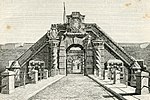The Sicilian Expedition was an Athenian military expedition to Sicily, which took place from 415–413 BC during the Peloponnesian War between Athens on one side and Sparta, Syracuse and Corinth on the other. The expedition ended in a devastating defeat for the Athenian forces, severely impacting Athens.
The expedition was hampered from the outset by uncertainty in its purpose and command structure—political maneuvering in Athens swelled a lightweight force of twenty ships into a massive armada, and the expedition's primary proponent, Alcibiades, was recalled from command to stand trial before the fleet even reached Sicily. Still, the Athenians achieved early successes. Syracuse, the most powerful state in Sicily, responded exceptionally slowly to the Athenian threat and, as a result, was almost completely invested before the arrival of back up in the form of Spartan general, Gylippus, who galvanized its inhabitants into action. From that point forward, however, as the Athenians ceded the initiative to their newly energized opponents, the tide of the conflict shifted. A massive reinforcing armada from Athens briefly gave the Athenians the upper hand once more, but a disastrous failed assault on a strategic high point and several crippling naval defeats damaged the Athenian soldiers' ability to continue fighting and also their morale. The Athenians attempted a last-ditch evacuation from Syracuse. The evacuation failed, and nearly the entire expedition were captured or were destroyed in Sicily.
The effects of the defeat were immense. Two hundred ships and thousands of soldiers, an appreciable portion of Athens' total manpower, were lost in a single stroke. The city's enemies on the mainland and in Persia were encouraged to take action, and rebellions broke out in the Aegean. Some historians consider the defeat to have been the turning point in the war, though Athens continued to fight for another decade. Thucydides observed that contemporary Greeks were shocked not that Athens eventually fell after the defeat, but rather that it fought on for as long as it did, so devastating were the losses suffered. Athens managed to recover remarkably well from the expedition materially, the principal issue being the loss of manpower rather than the loss of ships.












